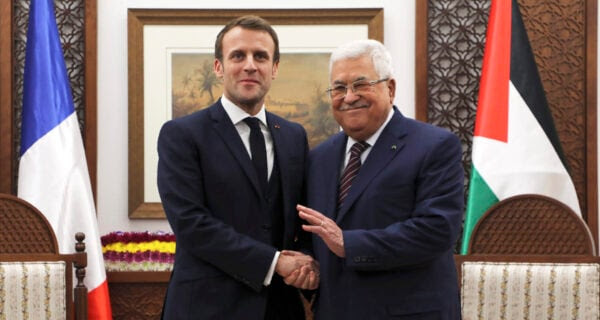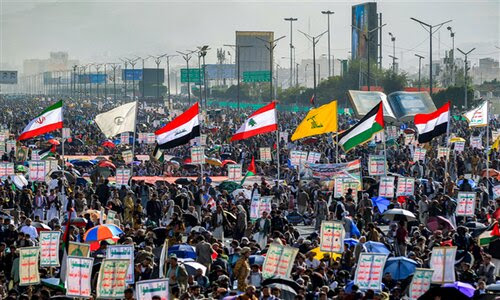
France to assist PA in drafting constitution for Palestinian state
France announced Tuesday it would join forces with the Palestinian Authority to draft a constitution for a potential Palestinian State, Reuters reported.
The decision followed a meeting in Paris between President Emmanuel Macron and Palestinian Authority President Mahmoud Abbas.
The French leader said the panel would examine legal, constitutional, and institutional questions that he argued must be addressed before any political transition can take place.
Macron framed the move as an opportunity for Israelis and Palestinians to “live side by side in peace and security.”
He referred to Abbas as a close partner and said France intends to stay involved in efforts to design what he described as “the day after.”
Several Western governments, including France, formally recognized a Palestinian state earlier this year, a shift driven in part by criticism of Israel’s conduct during the Gaza war and by renewed calls to advance a two-state formula.
Israel, despite accepting a US-mediated ceasefire with Hamas, has continued to reject recognition of Palestinian statehood, with Israeli Prime Minister Benjamin Netanyahu referring to such recognition after the Oct. 7 massacre as a “reward for terror.”
In July 2024, the Knesset voted overwhelmingly 67-8 to reject the establishment of a Palestinian state.
Abbas told Macron that the PA remains committed to creating a democratic, demilitarized state that includes Gaza, and said he is prepared to cooperate with President Donald Trump and additional international actors to move any peace initiatives forward.
Macron stressed that the committee’s mandate would be strictly technical but essential to future diplomacy.
Both leaders said the process could help provide a political track once fighting in Gaza is fully resolved, though neither offered a timetable for when that might occur.
SIGNS OF THE TIMES
Update and Clarification Regarding the Red Heifer from the Temple Institute and the Sanhedrin

The burning of the red heifer on July 1 marked a significant moment in Jewish tradition, sparking considerable discussion. The Temple Institute, which has long been preparing for this ritual, issued its first official statement on the event, addressing the various claims circulating across media platforms, such as YouTube.
Additionally, the Sanhedrin has issued its own statement regarding the event, lending further clarity and direction to the ongoing process.
Jewish tradition maintains that the red heifer is the most enigmatic and difficult to understand law that God gave us in the Torah. The Jewish sources discuss the multitude of details in depth, covering the laws regarding the requirements and aspects that disqualify the heifer, as well as the performance of the ceremony and how it was conducted during the days the Temple stood in Jerusalem. Few scholars are experts in the red heifer. Over a decade ago, the Temple Institute launched its red heifer project and tasked Rabbi Azariah Ariel with studying the subject in depth.
It should be emphasized that the red heifer is used to purify the nation of Israel from impurity resulting from proximity to or contact with a dead body. This state of purity is necessary for Jews to ascend to the Temple. Non-Jews do not become ritually impure and do not enter the Temple, so the mitzvah of the red heifer is not relevant to them, though the Talmud describes the purchase of a red heifer from a non-Jew to be used to purify Jews for the Temple service.
It should also be emphasized that Jews are currently the only verifiable descendants of Israel. Jewish law explicitly states that Jewish identity is genealogical, passed down from mother to children. Being part of the nation of Israel is not nor has it ever been a result of belief.
On July 1, a red heifer that had been housed at Shiloh by the Boneh Israel organization was prepared and burned on a pyre of wood at an undisclosed location in Samaria. The ceremony was carried out by a Kohen (a Jewish man descended from Aaron the priest). The cow was one of five red calves that were brought from Texas to Israel by Boneh Israel in September 2022
The Temple Institute statement reads as follows:
In light of incorrect information that has been published regarding the red heifer, the Temple Institute would like to announce:
1. For about ten years, the Temple Institute has been engaged in preparations for producing the ashes of the red heifer, both from an educational and practical perspective. The observance of these commandments, the raising of a red heifer according to Torah law, and the production of kosher ashes for the purification of the ritually impure, is very complex and includes thousands (!) of details, which require great knowledge and skill in execution. Therefore, the process also includes a number of practical experiments and exercises.
2. About three months ago, a practice was held in the Samarian mountains, in which a simulation of the making of the ashes of the red heifer was conducted.
3. Of course, ashes of the red heifer that are not made on the Mount of Olives while facing the site of the Holy Temple are completely invalid (Mishnah, Para 4:2; Rambam, Para Aduma 4:5). Therefore, we clarify that the simulation was only an exercise, part of a series of exercises that were and, with G-d’s help, will continue to be conducted, before we are properly prepared to fulfill the mitzvah according to Torah requirements. The act was not kosher for additional reasons, including: a heifer was chosen for the exercise whose overall color was red, but was, nevertheless, the most invalid and unkosher of the heifers in our possession. (Its tail was damaged, and it had a defect.) Likewise, the priestly garments worn by the kohen conducting the practice exercise were not consecrated. The purpose of the exercise was to improve our readiness for producing the ashes, and indeed, the exercise improved our understanding of the process, as well as the kohen’s skill, and also revealed various weak points that we must deal with, such as the proper way to lead the heifer to its destination.
4. For this reason, the ashes were mostly left by us in place without any care on our part. We did collect samples of the ashes by people who are tamei met, (impure due to contact with a corpse), and are therefore rendered ineligible for performing this mitzvah, only for the purpose of checking whether the equipment we have is suitable for the task, and important lessons were learned in this regard as well. In any case, all of the ashes are completely ineligible.
5. Anyone who claims otherwise, that the heifer was kosher and the ashes produced from it are kosher for the purpose of purification, is mistaken and misleading, either intentionally or unintentionally.
6. There are currently four red heifers at the Shiloh site, some of which are owned by Rabbi Ariel, head of the Temple Institute. Their halachic status has not yet been definitively determined, and we are monitoring them.
7. The real red heifer will be made, G-d willing, when we have a kosher red heifer (according to the opinion of the rabbis of the Temple Institute and the rabbis they consult with), and when we are ready in all other aspects of the matter. This is a long process that requires patience and perseverance.
After deliberation, the nascent Sanhedrin released a statement regarding the event:
Building Babies In Silicon Valley: The Pursuit To Engineer The Perfect Child

The investors behind these projects are the same figures driving the artificial intelligence revolution — men who believe technology can and should reengineer every aspect of human life. First, they taught machines to think. Now they want to rewrite the code of humanity itself.
GOG AND MAGOG UPDATE
Magog / Iran Seeking To Revive The ‘Axis of Resistance’ Against Israel

While US President Donald J. Trump and his administration are working hard to bring peace to the Middle East and disarm terror groups in the Gaza Strip and Lebanon, the Iranian regime and its proxies are doing their utmost to ensure that their Jihad (holy war) to destroy Israel continues in full force.
The Iranian regime is evidently (and understandably) afraid of losing its terror proxies – Hamas and Palestinian Islamic Jihad (PIJ) in the Gaza Strip, Hezbollah in Lebanon, and the Houthis in Yemen. These terror groups, whose primary goal is to eliminate Israel, have suffered severe blows over the past two years as a result of Israeli military operations targeting their leaders and military infrastructure.
Although Iran’s terror proxies have been weakened, they are trying to rise from the ashes with the help of their patrons in Tehran.
As part of their effort to foil Trump’s Gaza peace plan and attempts to persuade more Arab and Islamic countries to join the Abraham Accords with Israel, representatives of the Iran-backed terror groups attended a conference in Beirut in the first week of November organized by a group called the Arab National Conference.
According to Ziad Hafez, the group’s former general secretary:
“The Arab National Conference (ANC) is the prime popular Arab nationalist institution in the Arab world. Over the last three decades it has managed to reframe the Arab nationalist narrative and redefine the concept of Arab nationalism. The positions and statements of the ANC are key to the resurgence of Arab nationalism and to the understanding of events currently taking place in the Arab homeland.”
The conference was attended by more than 250 “Arab political, cultural, and resistance figures” from several Arab and Islamic countries. Key speakers included leaders of Hamas, PIJ, Hezbollah, and the Houthis, who declared that the “resistance [terrorism] remains the central path to confronting Israel and expansionist agendas across Palestine and the Middle East.”
Ma’an Bashour, a prominent Lebanese political figure, said that “resistance” is not merely military but “a political, cultural, and social framework essential for restoring sovereignty.”
ANC Secretary-General Hamdeen Sabahi emphasized the need to counter narratives of Arab defeat. “The nation has won, and the day of Palestine’s liberation is near,” he said.
Sabahi rejected calls by the Trump administration and the Lebanese government to disarm the Palestinian terror groups in the Gaza Strip and Hezbollah in Lebanon. These weapons, he added, “represent the dignity of the Arab nation.”
According to Sabahi, one of the outcomes of Hamas’s October 7, 2023 attack on Israel is the victory in New York City’s mayoral election of Zohran Mamdani, “who declared his allegiance to Palestine.”
The October 7 atrocities, Sabahi said, also showed that the process of normalization between Arab countries and Israel was “condemned to death on the [Arab and Islamic] popular level.”
Senior Hamas leader Khalil al-Hayya said in a speech before the conference that the October 7 massacres were “a response to attempts to obliterate the Palestinian cause and build a new Middle East.”
Al-Hayya added:
“October 7 registered an epic of heroism inside Palestine and on its borders when the nation participated, each according to its ability, in supporting us. The Al-Aqsa Flood [the name Hamas uses to describe the October 7 atrocities] has placed before us a great duty to develop plans and accumulate capabilities to move towards the liberation of Palestine [a euphemism for the destruction of Israel].”
This statement contradicts recent remarks by White House Middle East envoy Steve Witkoff, who said that Hamas officials told him and Jared Kushner that the terror group will disarm. In a speech before the America Business Forum in Miami on November 6, Witkoff said:
“Hamas has always indicated that they would disarm. They’ve said so – they said it to us directly during that famous meeting that Jared had with them. I hope they keep their word…”
If Hamas had any real intention of laying down its weapons, its leaders would not be participating in a conference that has come out in public against disarming terror groups in the Middle East. If Hamas were serious about implementing the Trump plan, it would not be participating in a conference that rejects it.
Ziyad al-Nakhalah, secretary-general of the Palestinian Islamic Jihad, the second-largest terror group in the Gaza Strip, and whose members participated in the October 7 attack on Israel, also expressed opposition to any plan to disarm terror groups.
“We are still in the field and we emphasize the need to protect the resistance,” al-Nakhalah told the ANC conference. He claimed that the Palestinian terror groups in the Gaza Strip “fought against an international coalition led by the US” over the past two years.
“We emerged from this battle with our weapons in our hands,” the PIJ leader said. Referring to the possibility that the terror groups would comply with Trump’s plan and lay down their weapons, he said: “Trump’s plan has set many obstacles and conditions that cannot be implemented.”
WATCH: IDF completes extensive three-day military exercise
#عاجل جيش الدفاع أكمل تمرين "زئير الأسد" لدى قيادة المنطقة الوسطى بمشاركة فرقتيْن ونحو 180 قطعة جوية وأكثر من 40 سيناريو طارئ
⭕️أكمل جيش الدفاع في وقت سابق من هذا الأسبوع تمرينًا واسع النطاق متعدد الأذرع لدى فرقة يهودا والسامرة والفرقة 96 التي أُنشئت مؤخرًا، بقيادة قيادة المنطقة… pic.twitter.com/pwEvPjUrqu
— افيخاي ادرعي (@AvichayAdraee) November 12, 2025